Ghost Bird, 2019
activism
American Resistor (2017) 1st ed. /
American Resistor (2017), 1st ed. 80 hand-pulled screen prints with graphite drawing on paper. The edition has 6 APs and 16 EPs that are not for sale (hence #58 on the main edition). This print is available for purchase in my shop.
Climate Change in Antarctica /
Kelly Heaton, "Climate Change (Penguins)," 2017. Digital photocollage comprised of an electronic circuit, a photo of Emperor Penguins in Antarctica, and pixel manipulation
Emperor penguins may disappear by the end of this century
By Lakshmi SupriyaJul. 7, 2017 , 10:30 AM
Emperor penguins are known for braving the harsh Antarctic winters, but they might not be able to brave the harsh realities of climate change. That’s the finding of a new study, which suggests that by the end of this century, the world’s largest penguins may be no more. Previous research suggested that rapidly warming air and sea temperatures—which melt sea ice—might cause their numbers to plummet by as much as 19% by 2100. But a new model looks at other factors, including how individual penguins deal with climate change by migrating to places with optimal sea ice coverage. In their model of potential penguin migrations, researchers looked at how far penguins typically go and what factors figure in their decisions. They used data previously collected from Pointe Géologie in Antarctica along with satellite images of penguin colonies that revealed information about their traveling and foraging behavior. The model projects that for the next 2 decades, populations will remain stable, and may even increase slightly as the penguins move to locations that are more habitable. After 2050, it all goes downhill. Although the rate of population decline may vary, by the year 2100 almost all emperor penguins may be gone, the researchers write in an upcoming issue of Biological Conservation. That’s because climate change will have rendered all their habitats inhospitable by then. Gaining endangered status under the U.S. Endangered Species Act, the scientists say, may be one way of arresting what might otherwise be their final march.
Posted in:
DOI: 10.1126/science.aan7070
http://www.sciencemag.org/news/2017/07/emperor-penguins-may-disappear-end-century
The Raft of Medusa /
"The Raft of Medusa" (1 in a series of 5 unique works), 2017. 39.5" x 54.25" Archival inkjet print, silk screen, and acrylic on canvas
I created five unique versions of this print during my summer residency at Otis College of Art and Design. This work was made possible thanks to support from Creative Capital, Otis College of Art and Design, Ronald Feldman Fine Arts, and volunteer models. "The Raft of Medusa" (1 of 5) will be donated to the Leonardo DiCaprio Foundation 2017 auction to raise money for environmental defense and climate change activism. For more information about the auction, please contact Lisa at Schiff Fine Art (info@schifffineart.com or (646) 478-8561). For more information about other prints in this series of 5, please contact Marco Nocella at Ronald Feldman Fine Arts (marco@feldmangallery.com or 212-226-3232).
BACKGROUND
Painted in 1818-1819, Théodore Géricault’s “The Raft of the Medusa” is a masterpiece of human error, desperation, and resilience. I recreated this legendary artwork for the purpose of climate change activism. I used a raft made of trash, rising ocean levels, and a carbon-saturated atmosphere to situate 21st century people adrift on a dangerous sea that they largely ignore. One occupant of the raft looks distressed, but the others are preoccupied with their cells phones or focused on other people. My message is reinforced with sea snakes and electrical cords that remind us of Medusa, the mythological woman who was cursed by Athena for her insufferable vanity.
Above: details from The Raft of Medusa (1 of 5), 2017.
Below: Images from my process of creating "The Raft of Medusa" series of 5 unique prints. The first three images show the raft that I built from trash collected in Los Angeles. The people are volunteers who came separately to be photographed on the raft. Using Photoshop, I collaged everyone into a single, coherent composition that I printed onto canvas using an Epson archival inkjet printer. Next, I created films for each design and color layer of silk screen. I burned a series of screens that I used to print "spot colors" of designs onto the canvas that add depth and texture to the rising ocean, the carbon-saturated sky, the electrical cords, and the serpents of Medusa. I screen-printed onto my inkjet print because I wanted to make nature and electricity literally encroach upon the raft and its occupants - who represent all of human civilization. Sadly, humanity is largely self-absorbed and unresponsive to the crisis of climate change.
Above top row: three volunteers from the community of Otis College of Art and Design who individually posed for The Raft of Medusa (2017)
Above middle row (left to right): my digital master file, selecting negatives for burning screens, applying photo emulsion to a silk screen. Photos of me working on the piece are courtesy of Antonia Jones of Los Angeles.
Above bottom row (left to right): rinsing my screen to reveal an image, registering my canvas prior to printing, pulling ink through the screen to print on the canvas. Photos courtesy of Antonia Jones of Los Angeles.
American Resistance, 2017 /
American Resistance, 2017. Carbon resistor painted with acrylic.
















